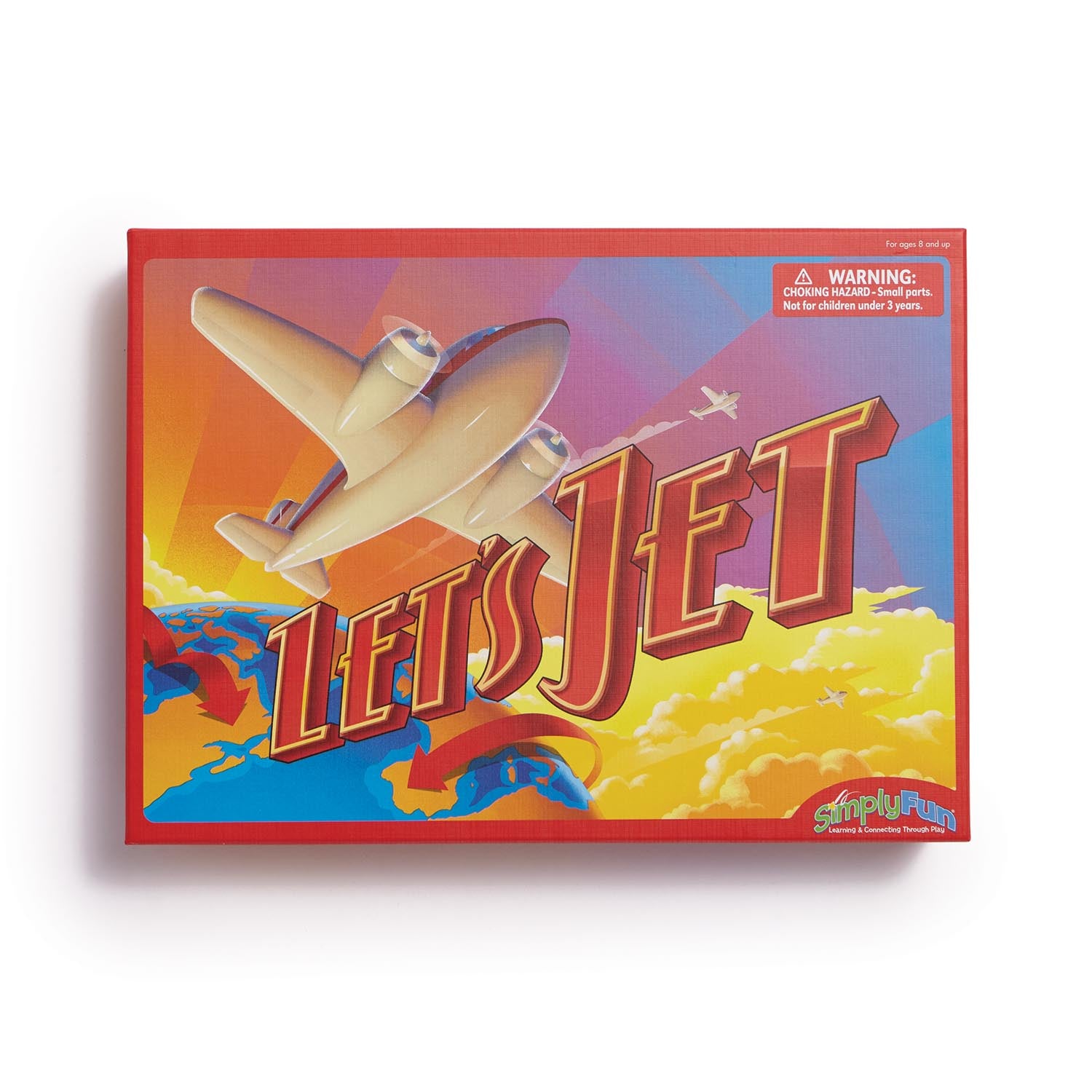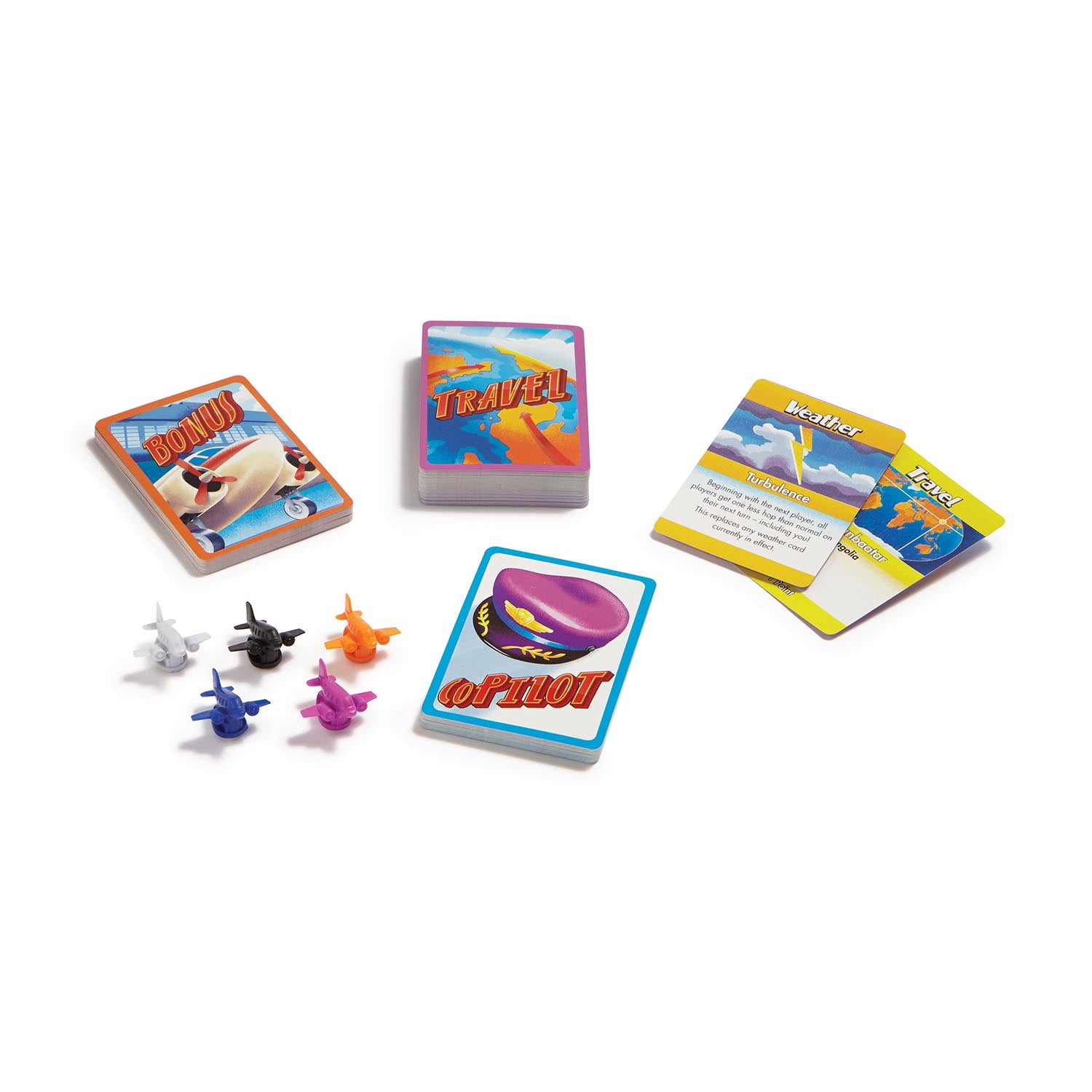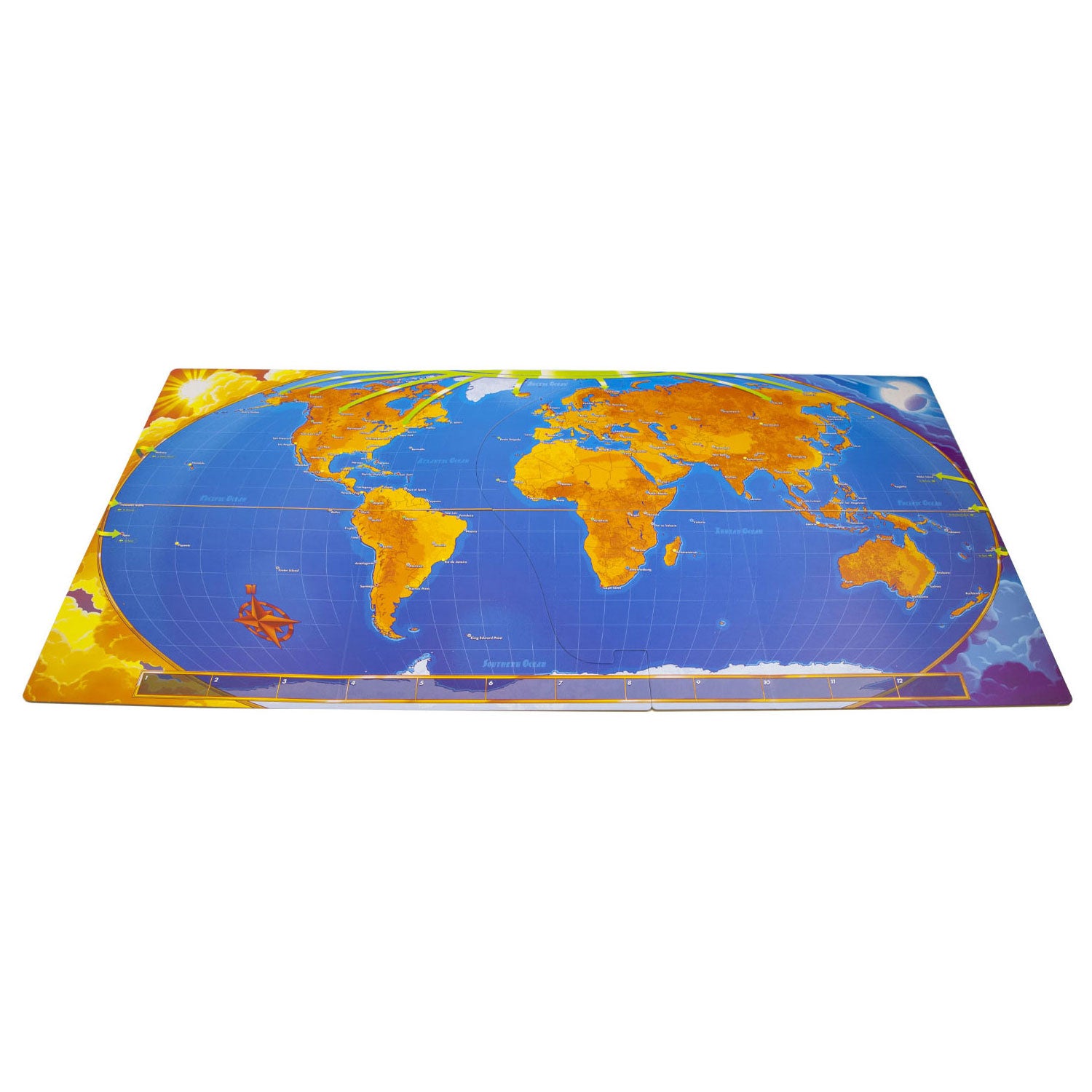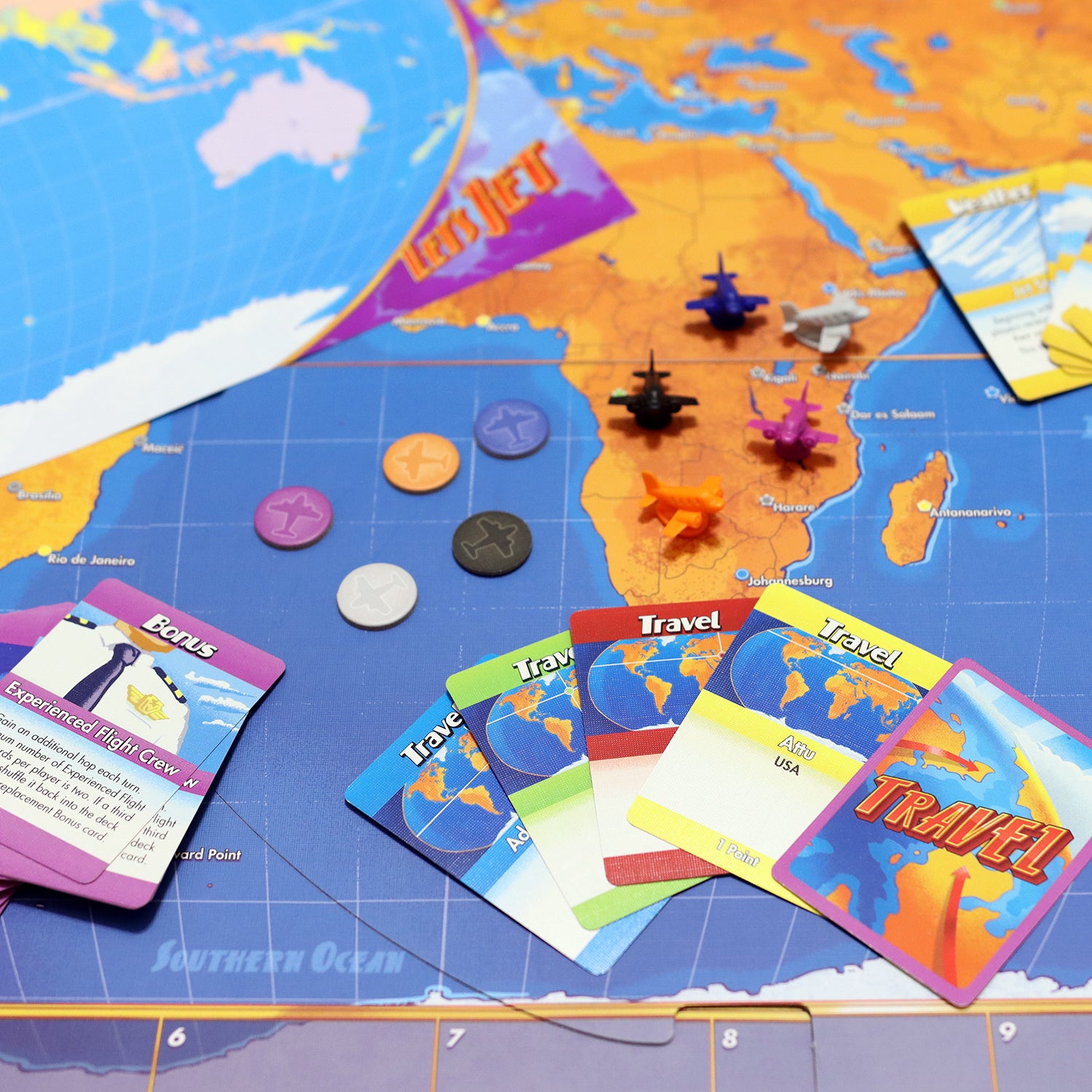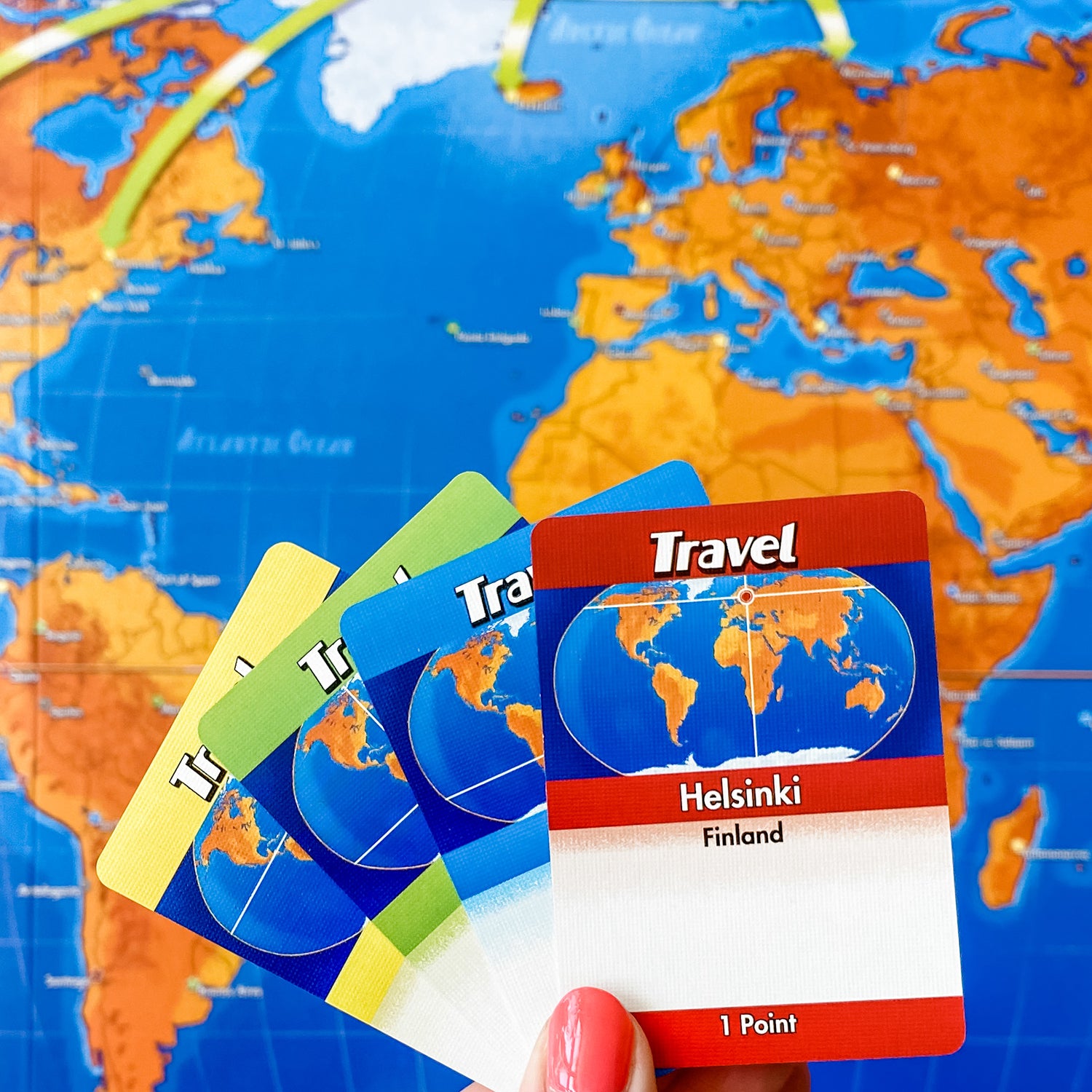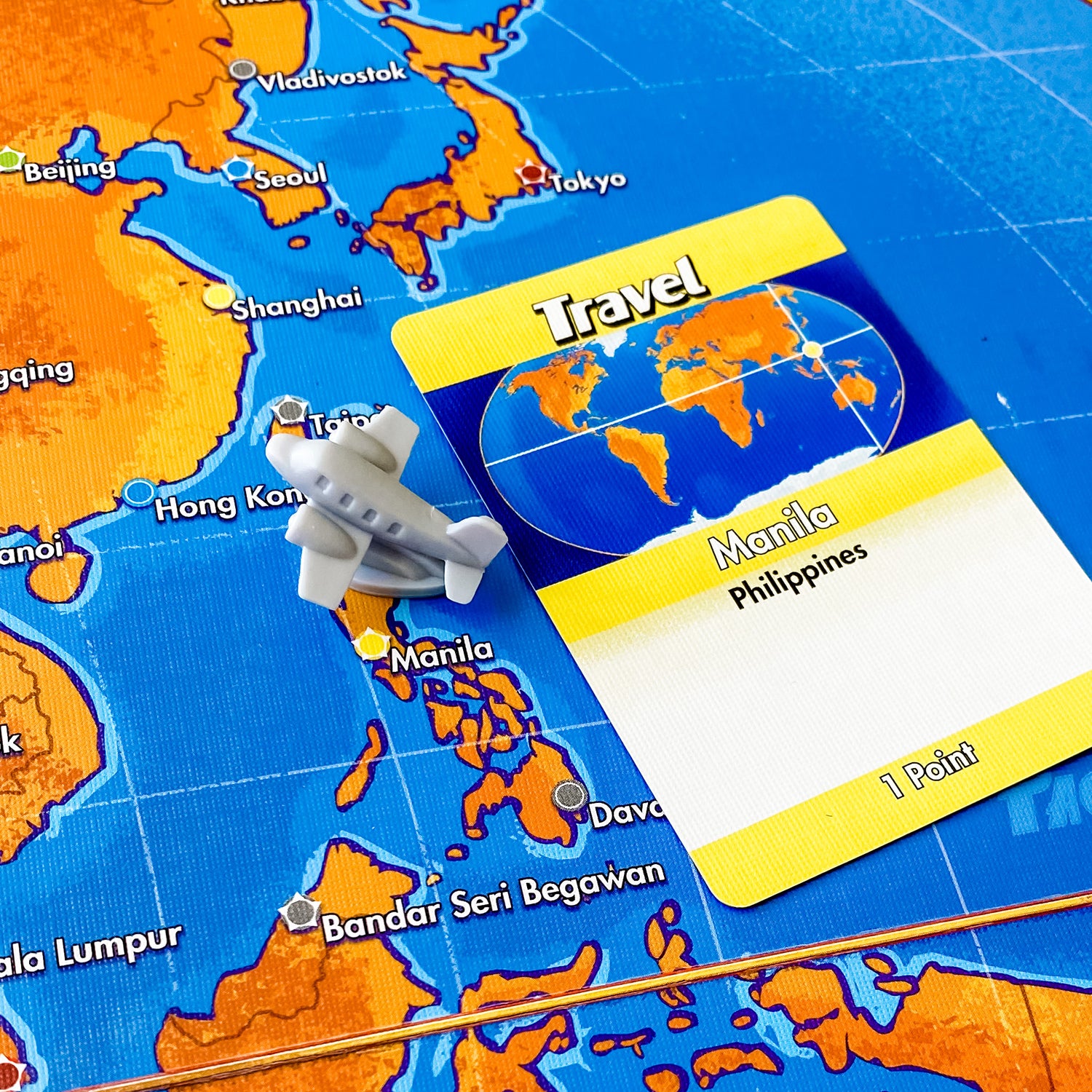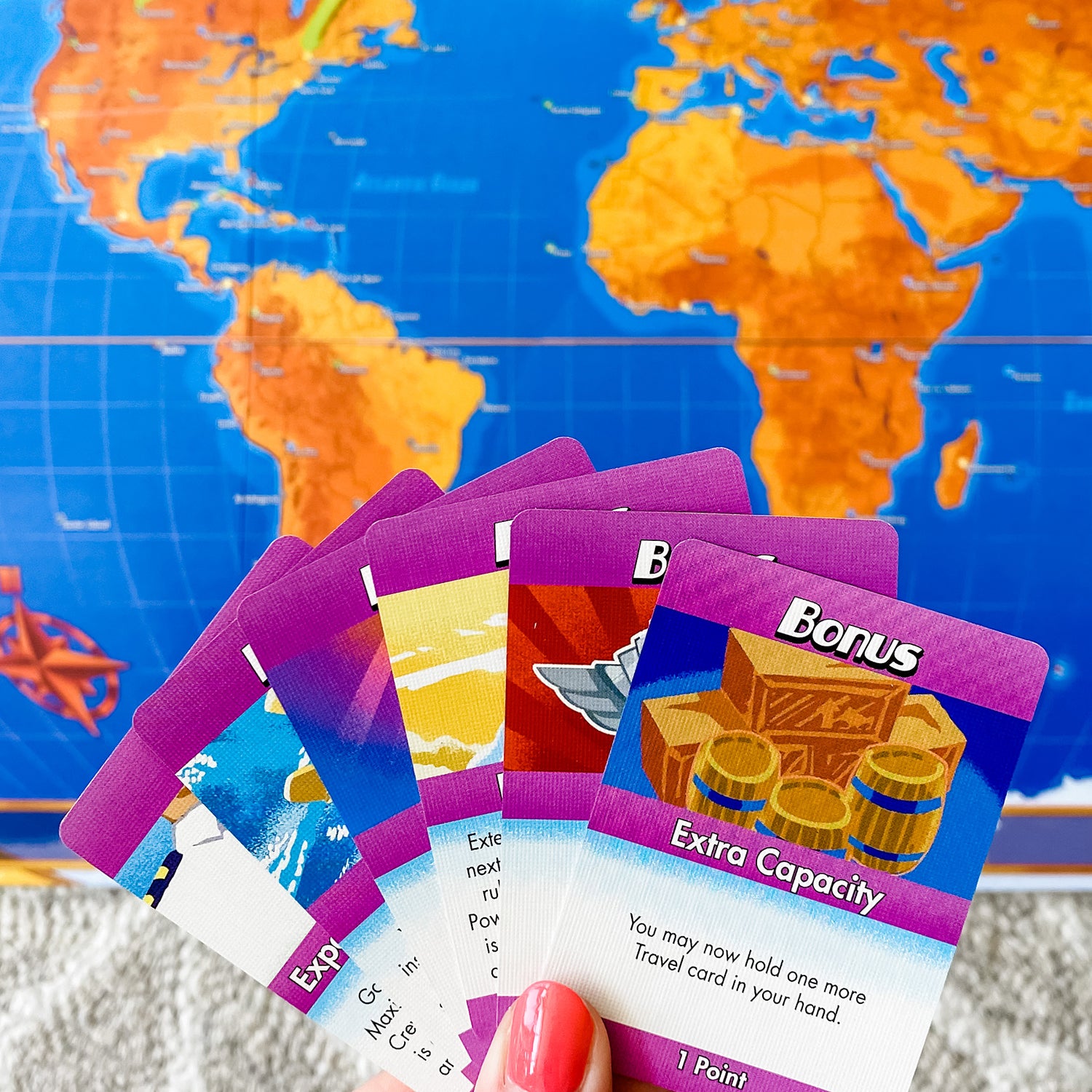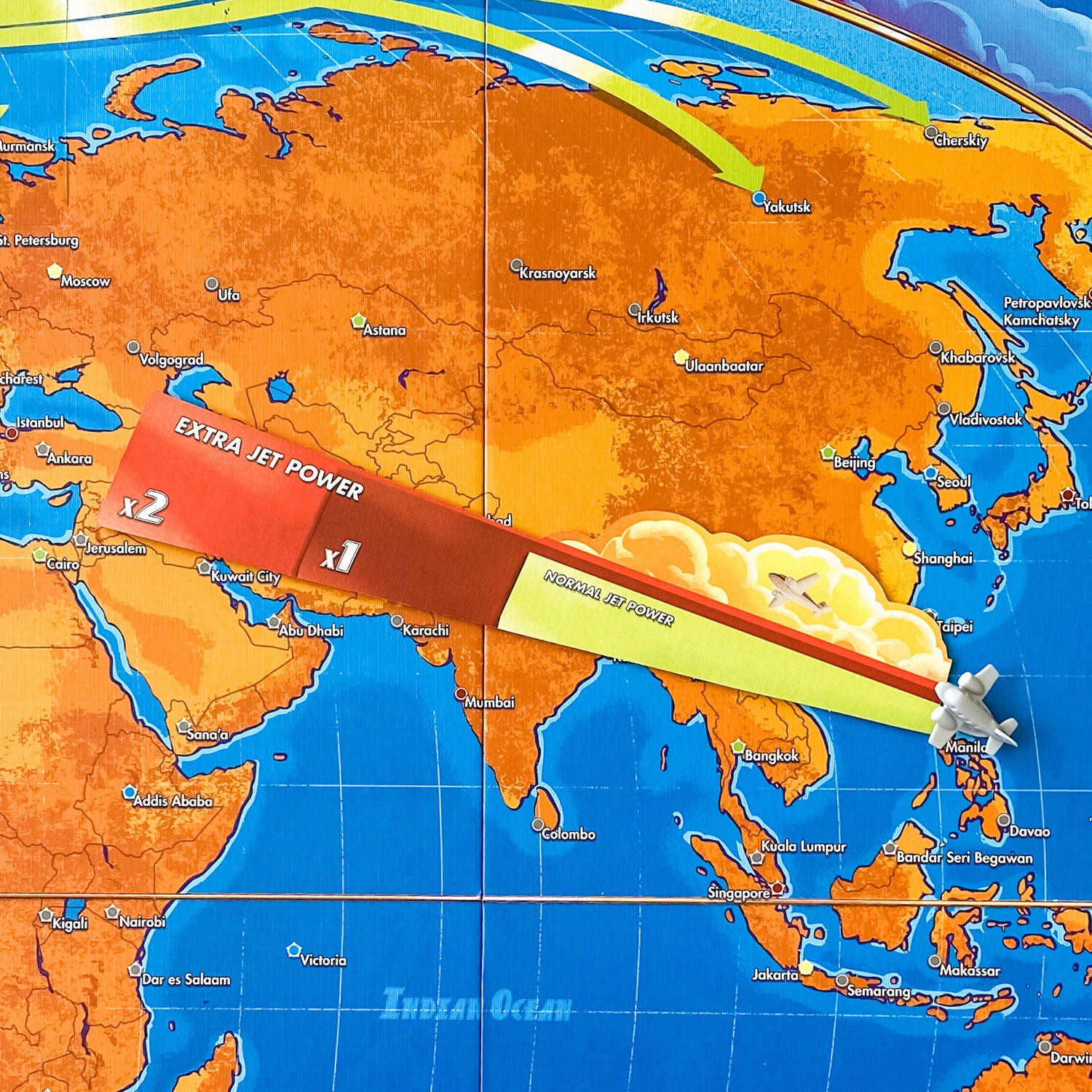Let's Jet
Let's Jet
2-5 players • 30 min • 8 & up
Focus: Geography
Couldn't load pickup availability
Get ready for a globe-trotting adventure! Explore neighboring countries, rack up points, and discover amazing world facts. Become a geography wiz while traveling the globe and learning about exciting destinations!
Skills: Geography, World Facts & Information
Game Includes
Game Includes
- 102 Travel Cards
- 24 CoPilot Cards
- 23 Bonus Cards
- 5 Jet Pawns
- 5 Scoring chips
- 2 Distance rulers
- 1 Game Board
- 1 Country fact sheet
- 1 Rules Booklet
Share
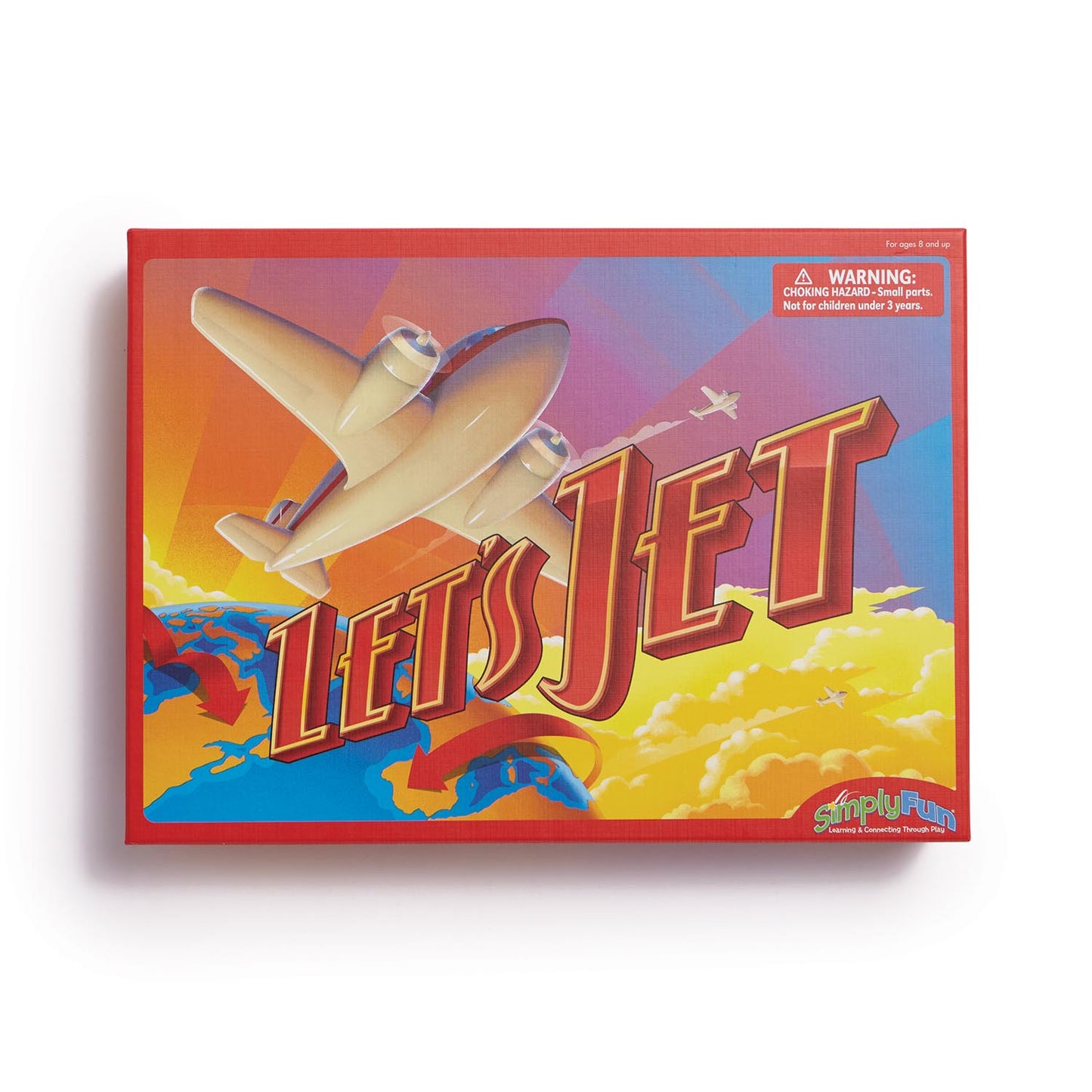
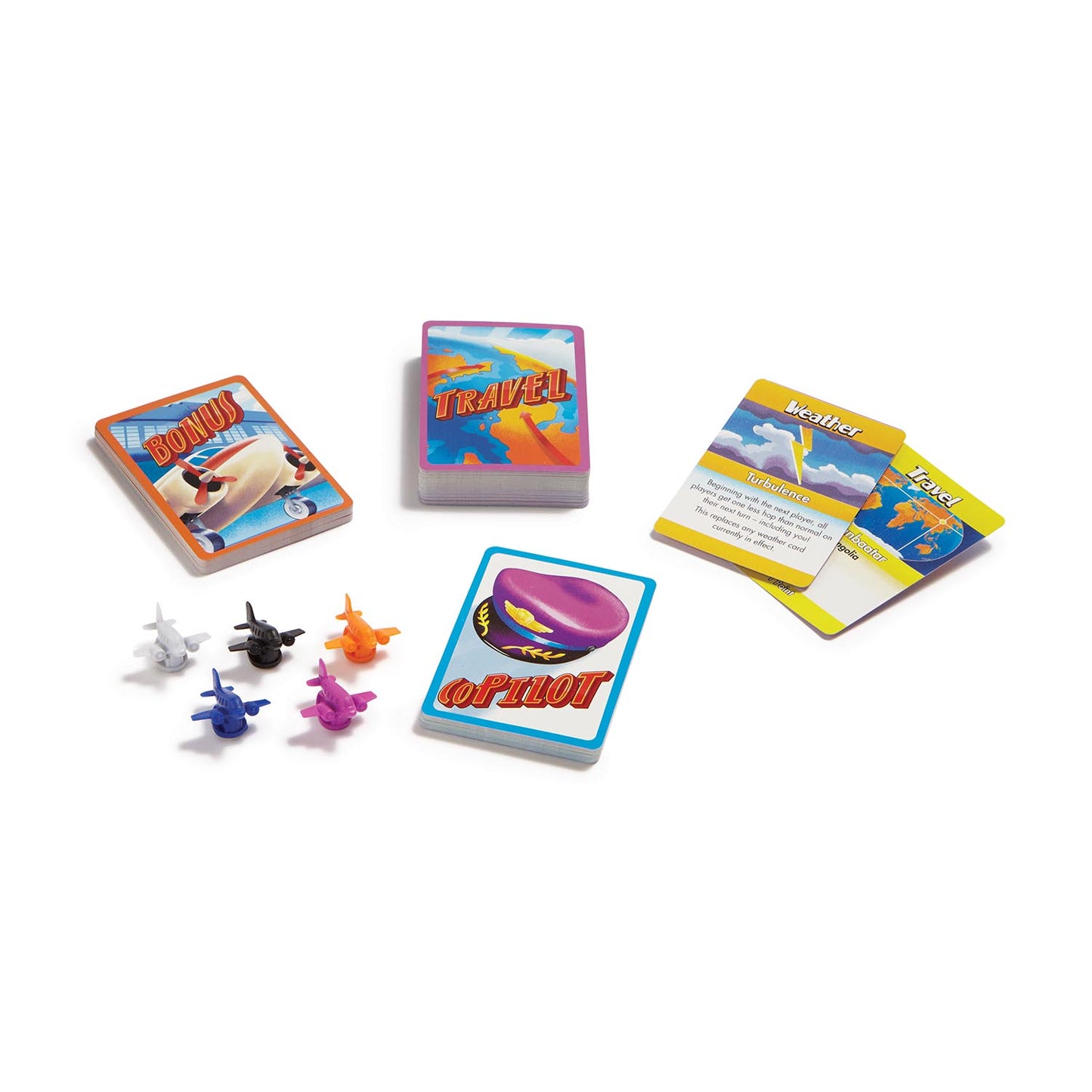
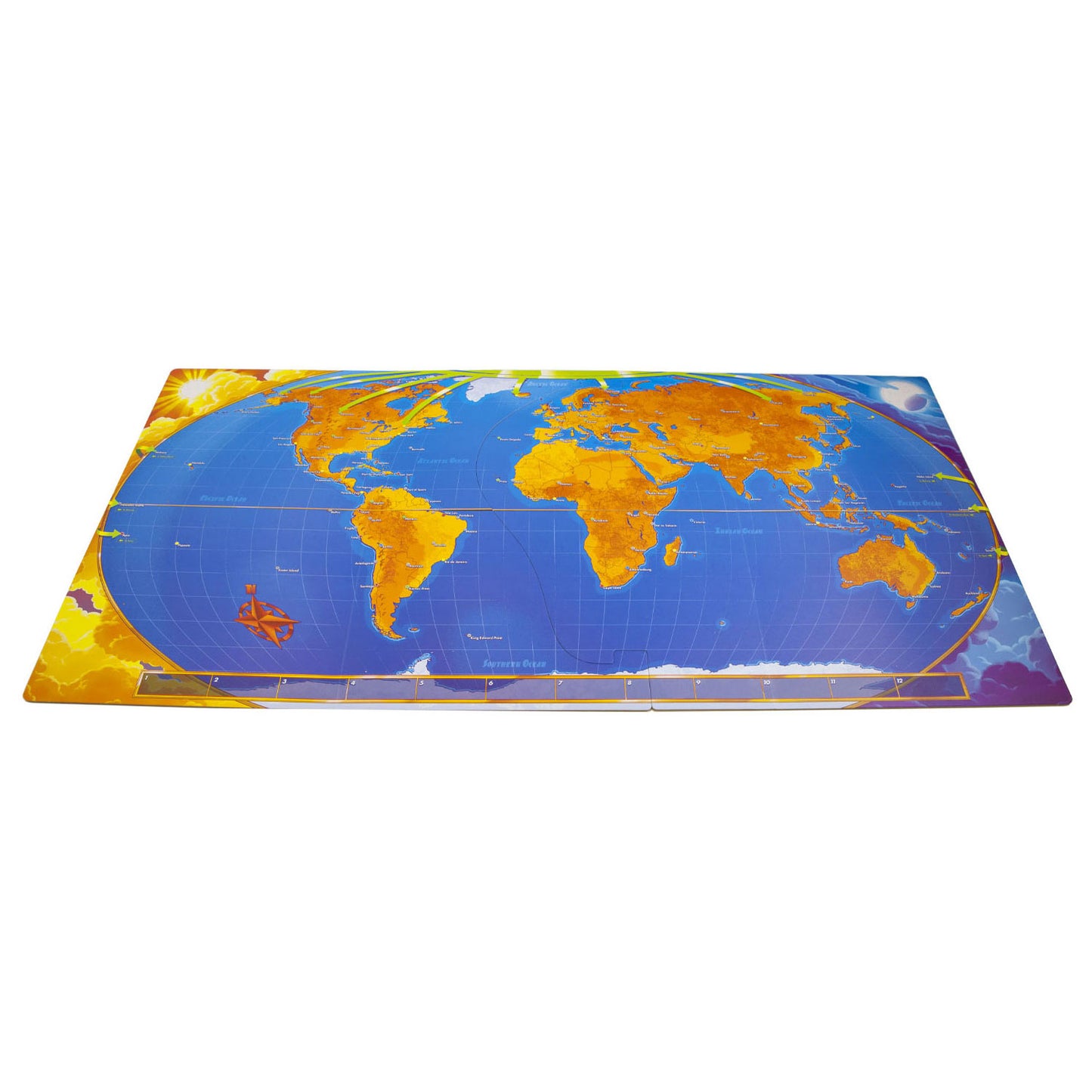
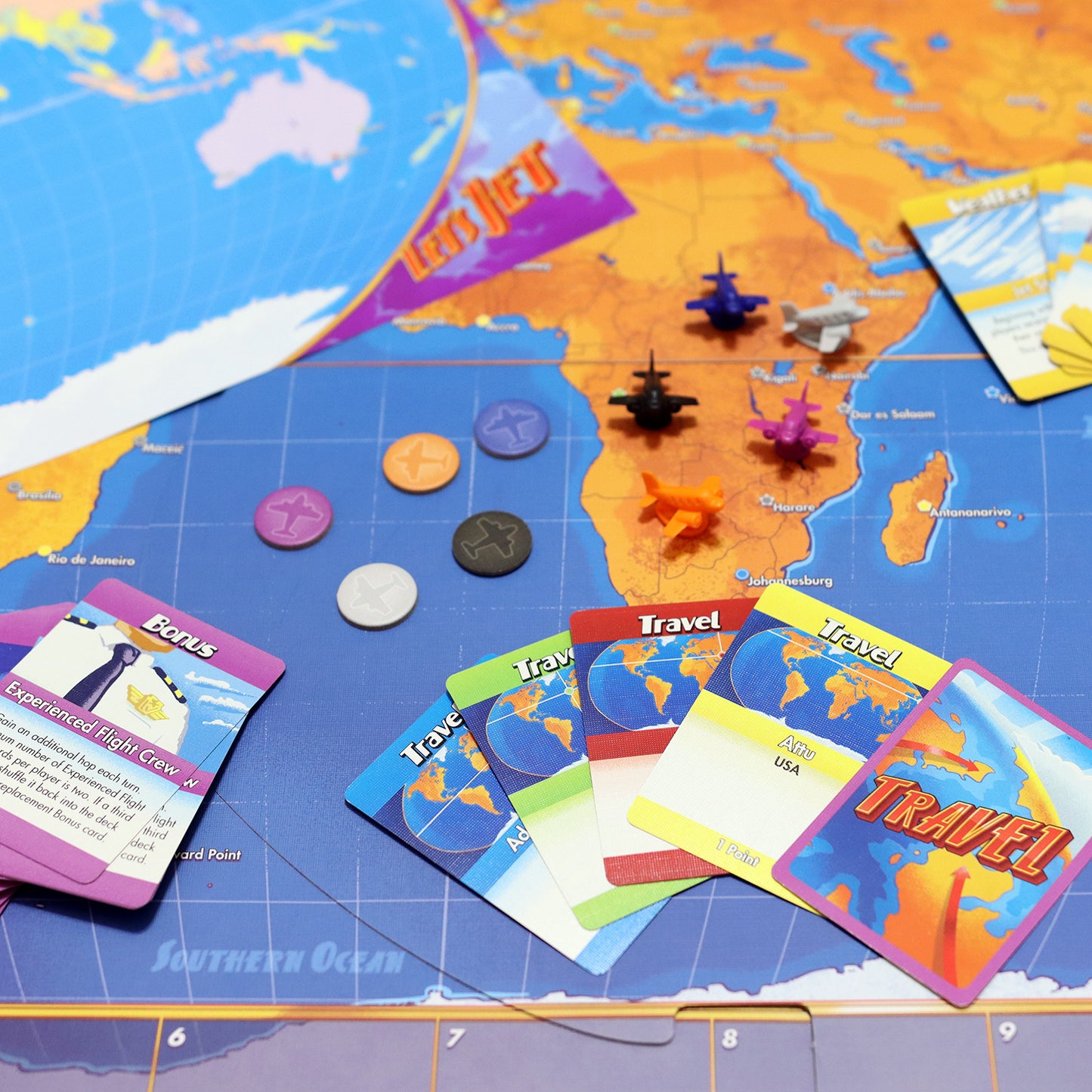
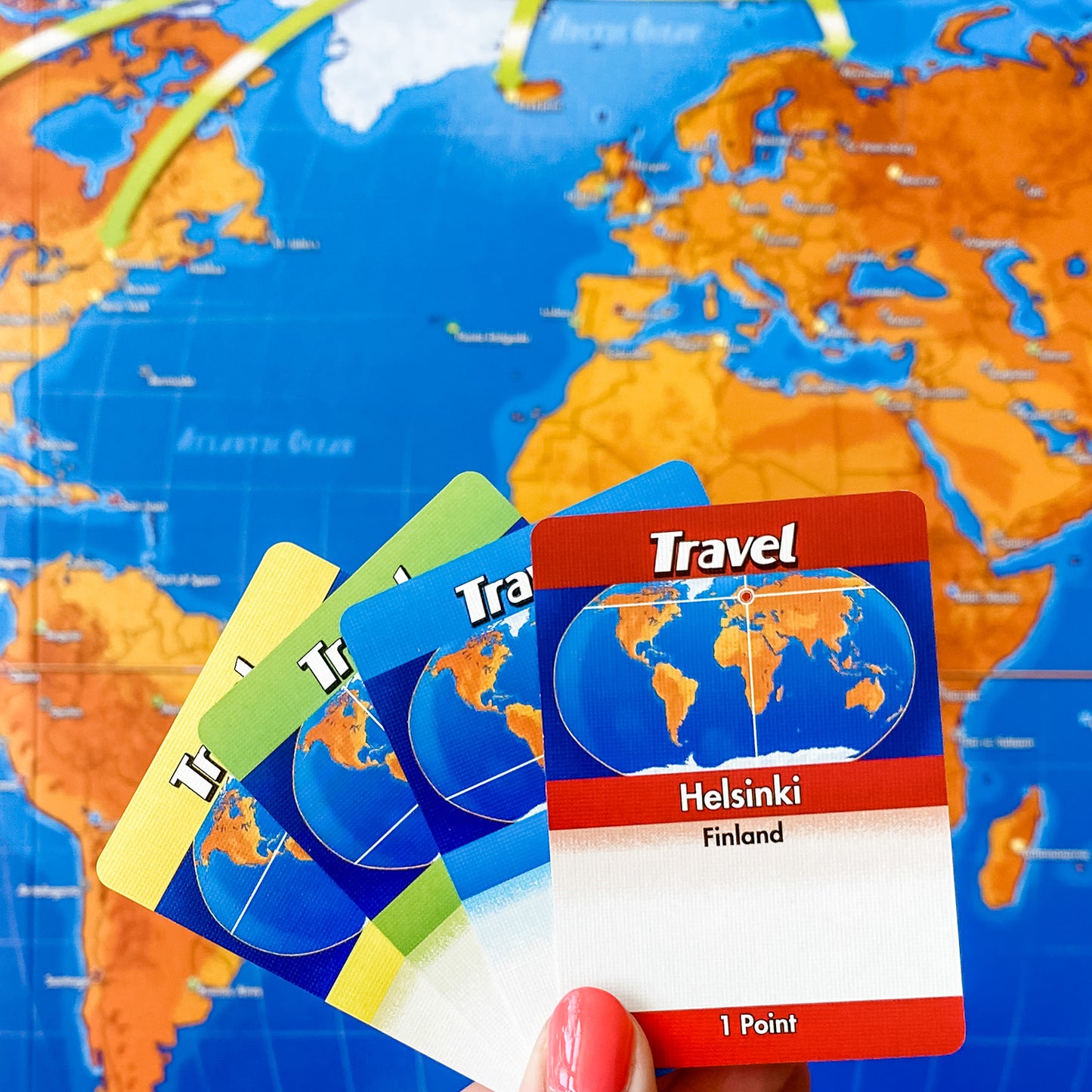
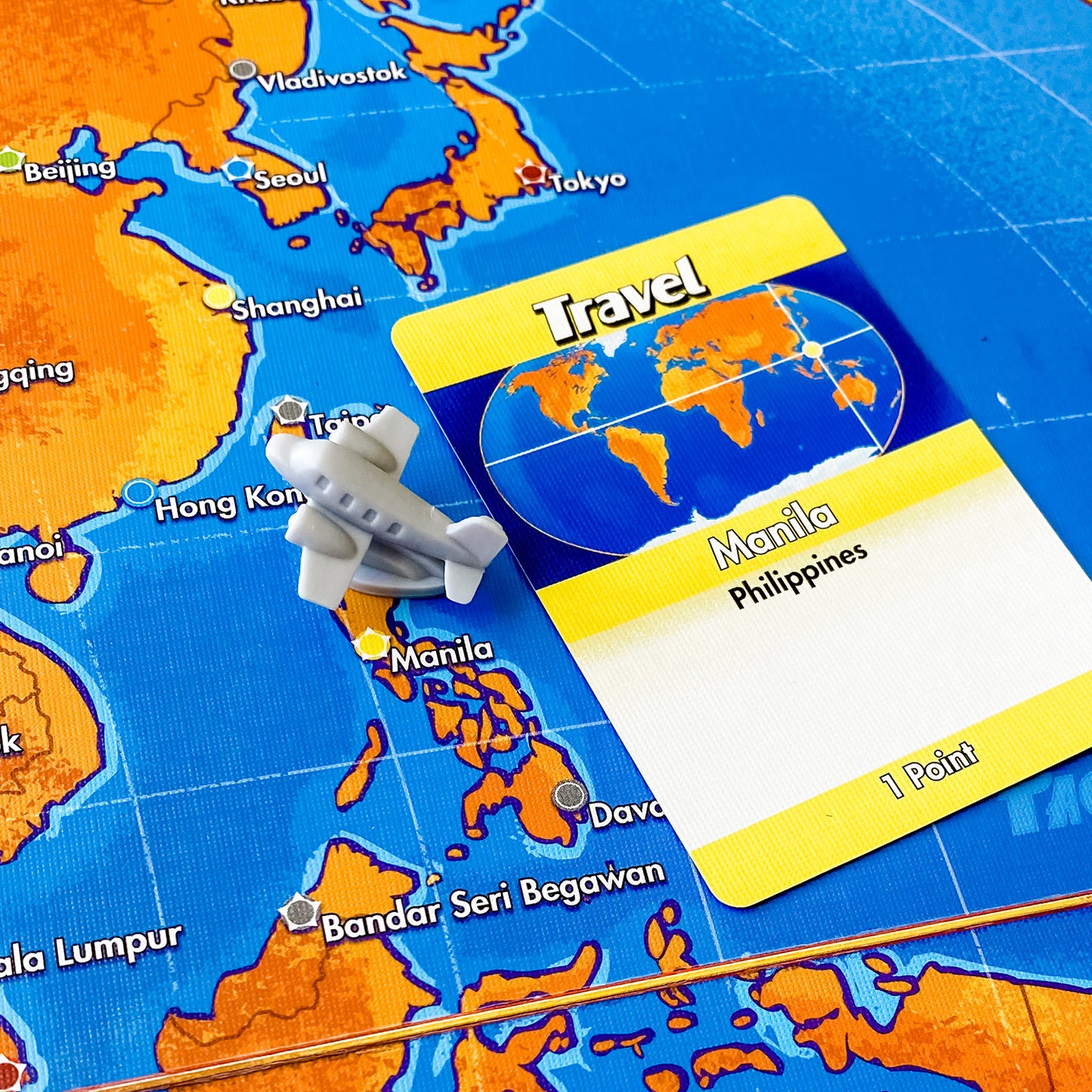
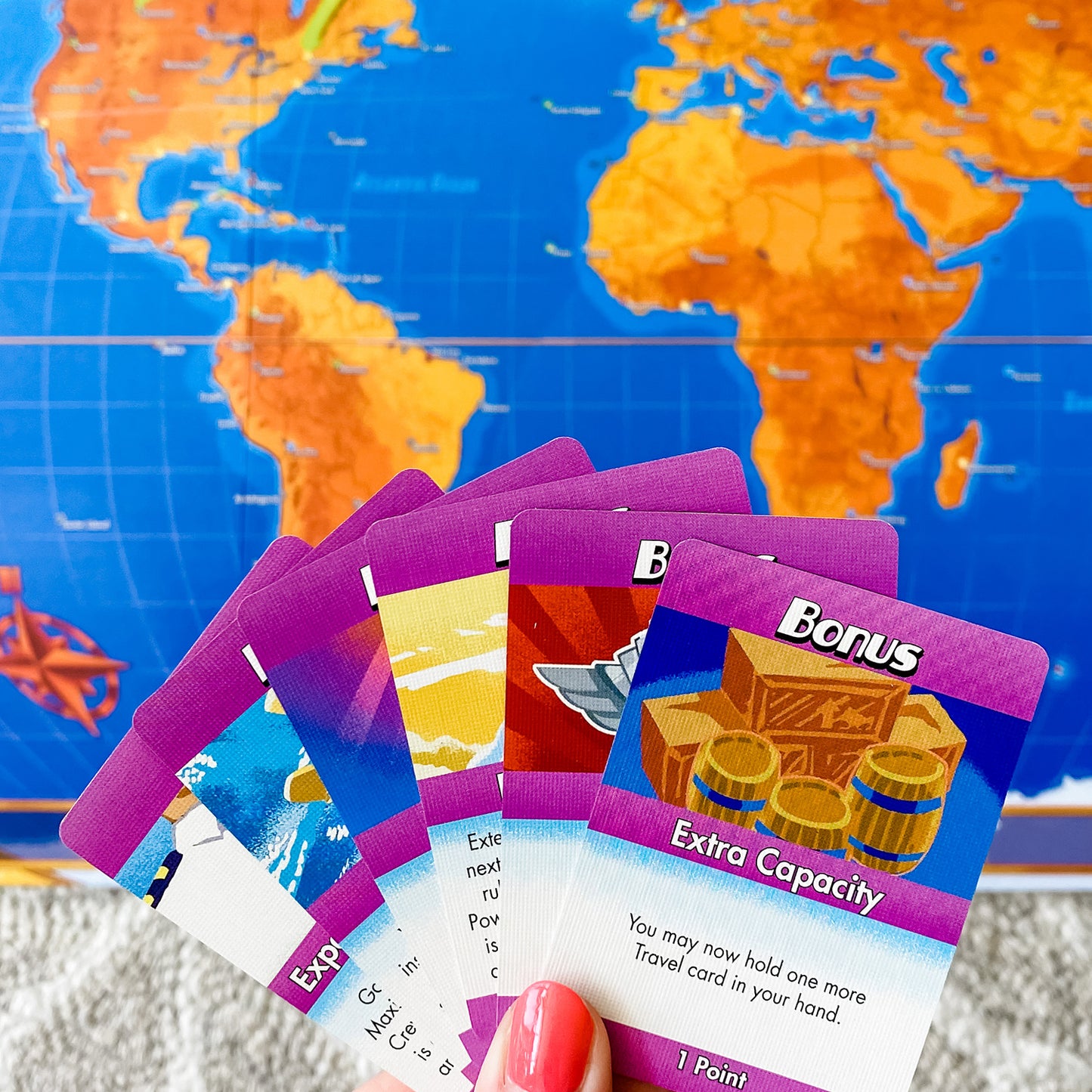
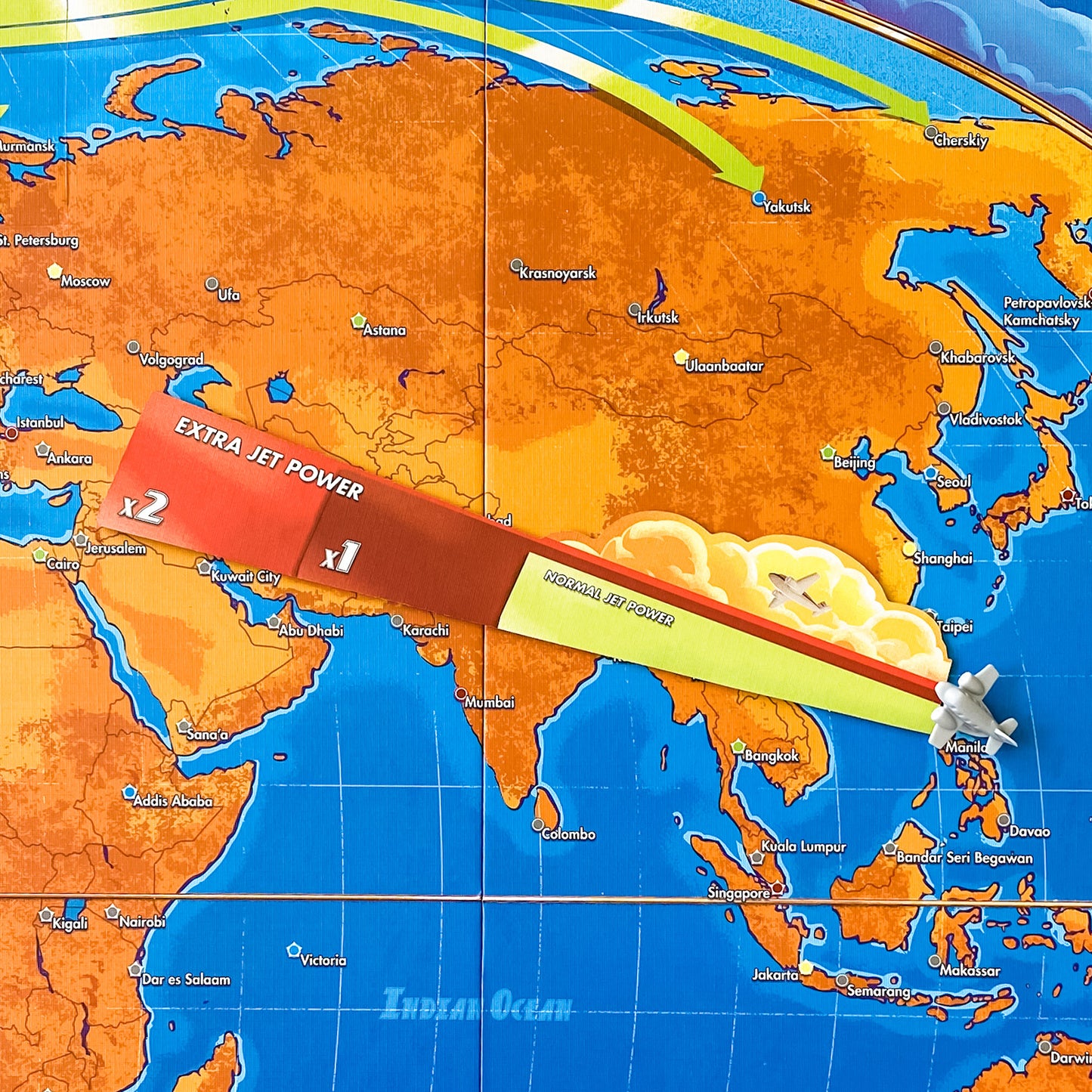
Collapsible content
How to Play
Educational Standards
Core Standard*: Language, Social Studies
Language
- Reading
- Informational Text
- Integration of Knowledge and Ideas. Grade Levels 3rd
- Range of Reading & Level of Text Complexity. Grade Levels 3rd
- Speaking and Listening
- Comprehension & Collaboration Grade Levels 3rd
- Language
- Vocabulary Acquisition and Use. Grade Levels 3rd
Math
- Mathematical Practice
- Make sense of problems and persevere in solving them. Grade Levels 3rd, 4th
- Use appropriate tools strategically. Grade Levels 3rd, 4th
History/Social Studies
- Geography
- Understands and applies basic mapping elements such as symbols, compass rose, labels and a key to reading and construct maps that display information about neighborhoods or local communities. Grade Levels 2nd
- Understands the physical, political and cultural characteristics of places, regions and people in North America, including the locations of the Fifty States within the regions of the U.S. Grade Levels 4th
Skills
Explore
What Does Child Do To Use Skill In The Game?
Players will explore the game board to look for different ways to fly around. Players may explore the fact sheet to learn more about the destinations on the game board.
How Parents Can Assist Learning
It is easy for children to ignore the factual aspects of the game, so parents play an important role in encouraging that the facts are read and enjoyed.
Learning Implications and Educator Support
It is easy for children to ignore the factual aspects of the game, so educators play an important role in ensuring that the facts are read and enjoyed. Let children explore the board before playing to discuss where they have been or may want to go because they have heard about it.
Educators can introduce children to geography concepts of continennts, countries, states, cities and capitals. Also, use directional language like above or below to help children look for location to place a Travel Card, if they are having difficulty.
Determine
What Does Child Do To Use Skill In The Game?
Players need to determine which Travel card they can reach on their turn, if any. Additionally, they need to determine the locations represented by the cards they have in their hand, which location cards are on the game board and what to do if they draw Event or Weather cards.
How Parents Can Assist Learning
Encourage children to use the Distance Ruler to determine which Travel destination(s) they can reach, if any.If children have difficulty associating a city with a location, remind them to look at the small map on the Location card which gives them a location spot on the map where the city is located.
Learning Implications and Educator Support
Children need to use spatial reasoning and measuring skills to play Let's Jet.If children have difficulty associating a city with a location, remind them to look at the small map on the Location card which gives them a location spot on the map where the city is located.
Compare
What Does Child Do To Use Skill In The Game?
Players compare locations and relative distance between locations as they move around the board. They also compare locations that may possibly result in collecting points. This is one of the key skills developed playing Let's Jet.Players may compare locator spot on their card with the game board to make a visual match, thereby, finding the city on the game board.
How Parents Can Assist Learning
Parents can encourage children to think about different routes. Point out options the child may not have considered, like going backwards or over the Arctic. Also, can the child see a route that would allow him or her to get more than one Travel Card or get very close to a second Travel Card?
Learning Implications and Educator Support
Visual matching is important skill underlying letter, word and number recognition, which in turn leads to reading and math fluency. It also supports pattern recognition and using landmarks for spatial orientation.Educators can encourage children to think about different routes. Point out options the child may not have considered, like going backwards or over the Arctic.
Plan
What Does Child Do To Use Skill In The Game?
Players make moves based on their hypothesis about what is the optimal way to get obtain or get near to Location card(s). In the advanced variation, players may also think about and take action to get sets of 3 colors in order to get bonus points. Planning is the key skill developed by playing Let's Jet.
How Parents Can Assist Learning
Encourage children to move the Distance Rulers around in order to see potential options prior to deciding on which location to fly to. Taking time to look at also supports regulating impulsivity.Also, encourage children to plan ahead, flying to locations where there are more of their and the public Location cards are located.
Learning Implications and Educator Support
Planning is an important skill for developing strategic thinking and reaching a goal. In Let's Jet, the planning includes spatial reasoning, and organization of Travel Cards to optimize number of cards that can be picked up on a turn.Planning is also essential to developing and executing strategies, as well as managing life's activities from going to school to cleaning up your room.
Educators can encourage children to count out the alternative paths to make the best decision they can. This also supports regulating impulsivity. Also encourage children to watch how other players plan their approach to their travel destinations and how they use the various options in the game.
Experiment
What Does Child Do To Use Skill In The Game?
Players measure and analyze different paths to see which will result in fewer moves and get them to their desired locations faster.
How Parents Can Assist Learning
Encourage children to move the Distance Rulers around in order to see potential options prior to deciding on which location to fly to.
Learning Implications and Educator Support
Encourage children to move the Distance Rulers around in order to see potential options prior to deciding on which location to fly to.
Practice
What Does Child Do To Use Skill In The Game?
Players practice measuring. With more play, they will get faster and may be able to "eyeball" distances more accurately.
How Parents Can Assist Learning
No special parent support required
Learning Implications and Educator Support
Educators can provide the children rulers so they can practice measuring in inches and centimeters.
Solve
What Does Child Do To Use Skill In The Game?
A successful strategic approach and experimenting with Distance Rulers to find optimal flight paths will result in players' capturing Travel Card(s) and gaining point(s). In the Advanced variation, players may also try to make a set of three to earn bonus points and, if they are paying close attention, will be able to win Co-Pilot points.
How Parents Can Assist Learning
If parents see that children are selecting locations that are not optimal or missing chances to earn bonus points, encourage them to look again closely and pay attention to the actions of other players. To provide additional support, show the child two options two examine and discuss why one would be a preferred choice to the other.
Learning Implications and Educator Support
This game involves uses of directionality, addition and if/then problem solving.As children play they learn new information constantly as different Travel Cards are selected, placed on board and removed by other players. This information directly effects how children strategize an approach for playing their cards and selecting flight paths to win the game.
Encourage children to remain flexible in their approach to the game. It is difficult to predict what opponents will do. Thus, it is important to adapt based on prior moves. Adapting is key to building resilience and creative problem solving.
Review
What Does Child Do To Use Skill In The Game?
Players may review if encouraged. See How Parents Can Assist Learning.
How Parents Can Assist Learning
At the end of the game parents can review player's cards and read the facts related to each. This can help build a child's curiosity about geography, cultures and history.
Learning Implications and Educator Support
Educators can use review of the game actions to introduce children to geography concepts of continents, countries, states, cities and capitals. At the end of the game, or after a player has landed at a city, review player's cards and read the facts related to each. This can help build a child's curiosity about geography, cultures and history.
Demonstrate
What Does Child Do To Use Skill In The Game?
Players may demonstrate if encouraged. See How Parents Can Assist Learning.
How Parents Can Assist Learning
To build cooperation and collaboration skills, parents can encourage children to assist each other by pointing out alternatives that may not have been considered by other children.
When a child is successful in getting to a city, the parent can ask, "What did you do that worked so well?" This encourages the child to talk about and even physically demonstrate their strategy.
Learning Implications and Educator Support
To build cooperation and collaboration skills, educators can encourage children to assist each other by pointing out alternatives that may not have been considered by other children.
When a child is successful in getting to a city, the educator can ask, "What did you do that worked so well?" This encourages the child to talk about and even physically demonstrate their strategy.
Imagine
What Does Child Do To Use Skill In The Game?
Children may use imagination if encouraged. See How Parents Can Assist Learning.
How Parents Can Assist Learning
To stimulate their imaginations, ask children to imagine where they would like to travel some day, what it might be like in those cities or countries, and what might they do when they get to those destinations. This can be especially effective after reading the city facts.
Learning Implications and Educator Support
To stimulate their imaginations, ask children to imagine where they would like to travel some day, what it might be like in those cities or countries, and what might they do when they get to those destinations. This can be especially effective after reading the city facts.
Create
What Does Child Do To Use Skill In The Game?
Children may be creative if encouraged. See How Parents Can Assist Learning.
How Parents Can Assist Learning
Encourage children to make up a story or a play. For example, one child could pretend to be a travel agent, and the others could come to the travel agent to plan the most unusual vacation. Adults could also encourage children to invent and create (build, draw, etc.) a new means of travel, such as a submarinaloon (a submarine combined with a big balloon).
Learning Implications and Educator Support
Encourage children to make up a story or a play. For example, one child could pretend to be a travel agent, and the others could come to the travel agent to plan the most unusual vacation. Adults could also encourage children to invent and create (build, draw, etc.) a new means of travel, such as a submarinaloon (a submarine combined with a big balloon).
*Data compiled from CCSSI ELA Standards, WA Science Standards, and Washington Social Studies Standards
Special Needs
Cognitive
Suggestions for How to Modify Play Experience
Children with cognitive delays might not understand the green arrows indicating flight around the world. Before starting the game use a real globe or a balloon to illustrate the game in 3 dimensions. If using a balloon, you can use a marker to roughly draw on continents. Using a small jet pawn demonstrate how the plane flies around the world. Show the child how the game board is the same as the globe only flat. Explain how the arrow on the board are like the jet flying around the balloon.
Children with cognitive delays may need assistance with reading the names of the cities. Other players can assist the child in finding where the public cards go. Placing the public cards is good practice for visual spatial matching. The child needs to look at the Travel card and locate where the cross hairs are on the card, then match this to the larger map. Once the child finds the general area on the board, they can try to find the city by finding the match to the word on the card. Adults can help children sound out the name of the city, if reading is a concern.
If the basic game is too complex for a child with cognitive delays, allow the child to be a co-pilot for another player. They can then work together to measure the distance between airports and fly the jet to the destination.
Communication
Suggestions for How to Modify Play Experience
Children with articulation concerns can practice sound production when they announce a city. Have them emphasize the problematic sounds as they say the city name. For example, if the child has difficulty with the letter "L," when they land on a city with the letter L in the name, such as Istanbul or Lisbon, the child can be encouraged to say, LLLisbon or IstanbuLL to emphasize the sound.
There are many interesting facts on the country Fact Sheet. Children can practice language production and comprehension with these facts. When a player arrives at their destination, have them place their Travel card in the score pile, get a point, then read the fact about the country to the rest of the players. After the next player takes a turn, all are asked to remember a fact about the previous destination. For example, a player lands on Kabul, then reads the facts about Afghanistan. After the next player's turn, the person who got the Kabul card asks, "What do you know about Afghanistan?" Anyone who can offer a fact gets an extra point, even if the fact was not on the Fact Sheet. Keep "memory" points on a separate piece of paper. These extra points are counted at the end of the game to determine the Fact Champ. This variation has several benefits. Children are forced to associate the city they landed in with the country, as they have to use the country fact sheet. The time lapse in between reading the facts and having to report them reinforces long term memory. Children reading the facts get practice in reading as well.
Sensorimotor
Suggestions for How to Modify Play Experience
Children with fine motor problems may need assistance with the measurement aspect of the game and accurate placement of their jet pawn. However, with minimal adult support the child can benefit from the practice the game allows. The adult may be able to stabilize one end of the measurement tool for the child so it doesn't move.
Another option is to for another player to place one finger on the jet's departure city and another finger on the destination city, so the child can measure the distance between the fingers.
Social Emotional/Behavioral
Suggestions for How to Modify Play Experience
Have children who are impulsive name two options to measure before they move their jet, unless the move is obviously within the jet's range. Making the child look at two options slows down impulsive thinking.
Children with Asperger's Syndrome or on the higher functioning end of the autism spectrum may enjoy this game due an interest in linearity or memory for geography facts. One enhancement for these children would be to give them actual rulers to make measurements. Their interest in numbers may motivate them to get exact measurement for each flight. Make a mark on the ruler to indicate the "normal jet power," " x1 Extra Jet Power," and "x2 Extra Jet Power."
Vision
Suggestions for How to Modify Play Experience
This game is not recommended for children with low vision.
Hearing
Suggestions for How to Modify Play Experience
Players who are hearing impaired should be able to play the game, if players hold up their cards for all to see or read as the game proceeds.
*Data compiled from CCSSI ELA Standards, WA Science Standards, and Washington Social Studies Standards
Autism
Autism Special Considerations
Appears to ignore other's communication and/or has difficulty giving eye contact to a communication partner
Is This Game Appropriate for Child with Characteristic? Yes
Can Child with Characteristic Play Game w/o Modification? No
Strategies for Developing Compensatory Skills:
Look at the game instead of each other.
Person talking holds the object being talked about near their mouth to bring the child's attention to the object. This also shows the child how the words about the object are produced. For example, hold the Destination Card up and say, "Tokyo."
Use unusual or exaggerated inflection to begin a communication about the game. This attracts the child's attention.
Has difficulty understanding complex verbal directions
Is This Game Appropriate for Child with Characteristic? Yes
Can Child with Characteristic Play Game w/o Modification? No
Strategies for Developing Compensatory Skills:
Break down directions into small steps. Don't go through all the directions at once. Start with the basic game without the advanced options.
Combine short verbal instructions with visual and physical examples of each step. For example, demonstrate using the measuring tool.
Check for comprehension by asking the child to show you what to do next. For example, when the child has an option of different routes, say, "What ways could you fly?" Let children read the directions as they are explained. Visualizing the words is often a stronger learning method for children with autism.
The game is not recommended for children who have difficulty with abstract concepts such as distance, measurement and comparison of distance and number of stops. Combining these with complex rules may be too overwhelming for some children with special needs.
Uses vocabulary inaccurately or demonstrates echolalia (repeating another's speech)
Is This Game Appropriate for Child with Characteristic? Yes
Can Child with Characteristic Play Game w/o Modification? No
Strategies for Developing Compensatory Skills:
Correct inappropriate word use and support with explanations.
Respond to immediate echolalia (repeating what was just said) by rephrasing the child's response into a correct format, so the child can hear and repeat that phrase. For example, assume you are playing with a child named Andy and you say, "Your turn," and Andy repeats, "Your turn." You can say, "It's Andy's turn. You say, my turn." This allows the child to hear and repeat the correct response. Eventually, the child will pick up the pattern of response.
Delayed echolalia (repetition of previously heard comments) may have a hidden meaning or association. Look for connection in the phrase used to the current situation. For example, the child says, "After these messages we'll be right back!" Think what the repeated phrase is associated with for the child. Try to interpret what is meant and rephrase it for the child. For example, you might respond by saying, "It sounds like you want a break for a few minutes. Is that what you mean? You can tell me, 'I need a break.'"
Gets stuck repeating a verbal topic or physical actions and/or has difficulty attending to others' actions or topic.
Is This Game Appropriate for Child with Characteristic? Yes
Can Child with Characteristic Play Game w/o Modification? Yes
Strategies for Developing Compensatory Skills:
Practice phrases for commenting on others' play actions. For example, you say to Joe (who is playing with you), Joe made it to Moscow. How did Joe do it? "
Remind children about listening and watching others' before making their own comment or action.
Extend the child's action to make a correct response. For example, if the child moves only one stop, say, "Keep going."
Reinforce attention and actions by commenting on what was done correctly. For example, "I love that you told me what your options were. That way I know what you are thinking about."
Has difficulty producing speech/communication
Is This Game Appropriate for Child with Characteristic? Yes
Can Child with Characteristic Play Game w/o Modification? No
Strategies for Developing Compensatory Skills:
Although communication is not required, players will want to communicate about various options in the game.
Extend the child's sounds into words or words into phrases to provide a model. For example, if the child says, New York, say, "You are flying to New York."
Provide at least 10 seconds wait time for the child to process or produce responses. It may take longer to formulate a thought or response for children with special needs.
Has difficulty sequencing multi-step actions and/or doing complex abstract tasks
Is This Game Appropriate for Child with Characteristic? Yes
Can Child with Characteristic Play Game w/o Modification? No
Strategies for Developing Compensatory Skills:
Use physical actions to walk through steps numerous times, with less support for the final step each time. For example, walk through the steps of looking over the options, picking a destination card, looking at options for routes, measuring a route, and moving a plane. Then do the first three steps and say, "What do you do next?"
Ask children to identify each destination card they have, then ask them to compare the number of stops to each. Ask which has the fewest stops. For some children with special needs, the tasks required in the game will be too abstract.
Demonstrates difficulty initiating and maintaining social interactions
Is This Game Appropriate for Child with Characteristic? Yes
Can Child with Characteristic Play Game w/o Modification? Yes
Strategies for Developing Compensatory Skills:
Social interactions are not required, but players will want to compare their moves and discuss them.
Develop a social story to be read at the start of a game. A social story is a short booklet that illustrates how a child can use positive social skills. It includes two to five descriptive statements and a directive statement. For example: "When I watch others, I will know when it is my turn. Others like me when I take turns. I will watch what others do with their pieces and listen to what they say. Others like it when I talk about the game." Add photos or drawings of the child doing the actions described in the story.
Role play social situations and reinforce appropriate words and actions. For example, role play finishing the game and congratulating the winner. Or, role play commenting on another player's turn. For instance, model for the child asking, Did you like what I did?"
Use video feedback of positive social behaviors. Video of actual play enables children to see what they or others did. Appropriate actions and interactions can then be discussed.
Acts out or demonstrates avoidance behaviors when frustrated, overwhelmed, or needs more sensory input.
Is This Game Appropriate for Child with Characteristic? Yes
Can Child with Characteristic Play Game w/o Modification? No
Strategies for Developing Compensatory Skills:
A weighted vest worn during the game may provide additional pressure input and thus reduce fidgeting due to sensory needs. Pressure can be calming when used for no more than 20 minutes at a time.
Practice a phrase to ask for help and role play situations in the game where it is needed.
Provide techniques for self-calming, such as holding a special toy.
Allow time for movement. For example, a child who needs to move frequently can be given an opportunity to 'celebrate' their turn by running around the table or jumping up and down 10 times.
Has short attention span for non-preferred activities
Is This Game Appropriate for Child with Characteristic? Yes
Can Child with Characteristic Play Game w/o Modification? No
Strategies for Developing Compensatory Skills:
Provide a break when needed.
Frequently remind the child of the goal of the game. "Don't forget you get points for reaching destinations."
Incorporate a motivating activity as part of the play. For example, each player gets to manipulate a fun 'fidget' toy, such as a stress ball or squeeze toy.
If the child has a short attention span for visual spatial tasks, the game may be inappropriate.
Needs sameness or consistent routines and/or has difficulty with transitions from one activity to another
Is This Game Appropriate for Child with Characteristic? Yes
Can Child with Characteristic Play Game w/o Modification? No
Strategies for Developing Compensatory Skills:
Play games at the same time every day, so the child anticipates the game routine.
Change the location of the game, so the child may play in different rooms, at the table, or on the floor. This will build tolerance for variation. Prepare the child ahead time for the introduction of a new game. Talk about aspects that will be motivating for the child, and let them explore the parts of the game before setting out the whole game.
Provide a structure for placement of game pieces that can be the same each time the game is played. For example, have a specific location for where the board goes, the pieces, etc.
Provide choices for how the child can be involved in set up or clean up. For example, you might ask, "Do you want to put the public cards or give each player destinations?"
Involve the child verbally and with actions for the transition to the game table or at the end of game play. For example, you might say, "Let's look at the pictures on the game box and guess what it is about."
Use an object cue. Let the child hold an object from the game or activity you want to introduce prior to the transition. For example, if you were intending to play Let's Jet, you would hand the child a jet pawn from the game and say, "Look here is a jet. Let's find the game it goes with?"
Has difficulty understanding others' feelings, intentions, and the reasons for others' actions.
Is This Game Appropriate for Child with Characteristic? Yes
Can Child with Characteristic Play Game w/o Modification? No
Strategies for Developing Compensatory Skills:
Model and point out what others are feeling and comment on their facial expressions or words.
Discuss what causes feelings in others. For example, "You are happy because you got to London. But, look at Joe's face. He is not happy because he has a long way to go!" Ask child to explain their own feelings and intentions.
Ask child to explain why other players did specific actions in the game.
*Data compiled from CCSSI ELA Standards, WA Science Standards, and Washington Social Studies Standards
Extended Play
Extra Ways to Play the Game
Divide the Travel deck into two sets of cards, one set that relates to cities on the right hand board and one set that relates to the cities on the left hand board. Give each player a real ruler. Each player draws one Travel card. The player on the right hand side of the board is Player One. The player on the left hand side of the board is Player Two. Player One is trying to fly to Player Two's city and vice versa. For this game, when flying over land, the increment is no more than 4 inches per hop. When flying over the ocean (with no land at all) the increment is no more than 5 inches per hop. Player One tries to get to Player 2's city in the shortest cumulative distance. Using the jets and the scoring tokens, Player One maps out thier her journey and places a token or jet at each stop along the way. Once a token or jet is placed on the board it cannot be moved. Once the journey is complete, Player One uses a ruler to measure the route, and adds up the total. Depending on the players understanding of measurement, they can round up to 1/8, 1/4 inch etc. Player Two can agree with the chosen path as being the shortest or select another path that they think is either shorter or has fewer stops. Fewest stops and shortest distance takes both Travel cards. Shortest distance OR fewest stops gets one Travel card.
Materials Needed
One die.
Developmental Benefits
Adding a die increases strategic difficulty of game by introducing unpredictability. Anticipating and predicting based on variables, rather than consistent data, is important to cognitive development.
Extra Ways to Play the Game
There are many interesting facts on the country Fact Sheet. Children can practice language production and comprehension with these facts. When a player arrives at their destination, have them place their Travel card in the score pile, get a point, then read the fact about the country to the rest of the players. After the next player takes a turn, all are asked to remember a fact about the previous destination. For example, a player lands on Kabul, then reads the facts about Afghanistan. After the next player's turn, the person who got the Kabul card asks, "What do you know about Afghanistan?" Anyone who can offer a fact gets an extra point, even if the fact was not on the Fact Sheet. Keep "memory" points on a separate piece of paper. These extra points are counted at the end of the game to determine the Fact Champ.
Materials Needed
No additional materials are needed.
Developmental Benefits
This variation has several benefits. Children are forced to associate the city they landed in with its country. They must find the city alphabetically on the country fact sheet, and they find the number of the country associated with that city. The time lapse in between reading the facts and having to report them reinforces long term memory. When children read the facts they also get practice in reading aloud. Reading aloud is valuable for learning and reinforcing essential language arts skills. Sharing content from the country fact sheet helps others learn information that relates to grade 4-5 social studies.
*Data compiled from CCSSI ELA Standards, WA Science Standards, and Washington Social Studies Standards
Collapsible content
How to Play Video & Transcript
This game teaches geography in a fun new way! Let's Jet is a set-collecting strategy game for up to 5 players aged 8 and up. The basic game takes less than 30 minutes to play, and advanced rules are available for those who are ready to tackle a challenge!
The game contains a deck of 102 travel cards featuring cities all over the world, plus two smaller decks of bonus rewards for completing three of a kind or helping another player reach their destination. The cute sculpted jet pieces are your player markers, and the distance rulers are used to calculate flight paths directly on the oversized world map.
Each destination card includes a map to help you find the location. All students (and adults) will benefit from hearing the names of countries and cities across the globe. The game also includes a full color fact sheet with fun facts about over 60 countries, and where to find them on the game map.
For the basic game, remove all event cards from the travel deck, and set aside the bonus cards. Shuffle the decks, and deal three public cards directly onto the map. Anyone may travel to these cities to claim them for points. Also deal each player four cards. Each should select one city as their starting location, and place this card face up in front of them as their first point. Set each player's scoring marker on the 1 space. The last person who travelled on an airplane begins the game.
Using the distance ruler, find a nearby city that you can reach by measuring with the green distance shown as 'normal jet power'. Try to come up with a flight plan that moves you closer to one of the cards you hold, or one of the public cards.
In the basic game, the winner is the first to reach 10 points. Once you've played a few times, you're ready to add the extra fun of events, bonus cards and copilot cards which also extends the game to 12 points.
One of the realistic gameplay features of Let's Jet is the ability to travel near the north pole, using a 'polar circle' route, just like the airlines do to reduce travel time of international flights!
So that's the exciting world-geography game we call Let's Jet! Take a trip around the globe and be surprised how much you happen to learn about geography while you're busy having fun.



